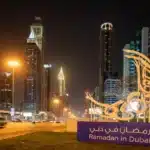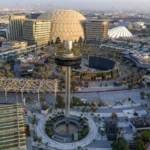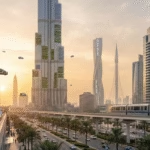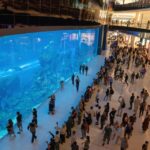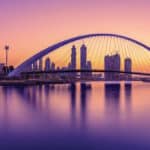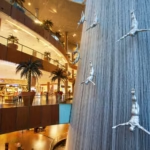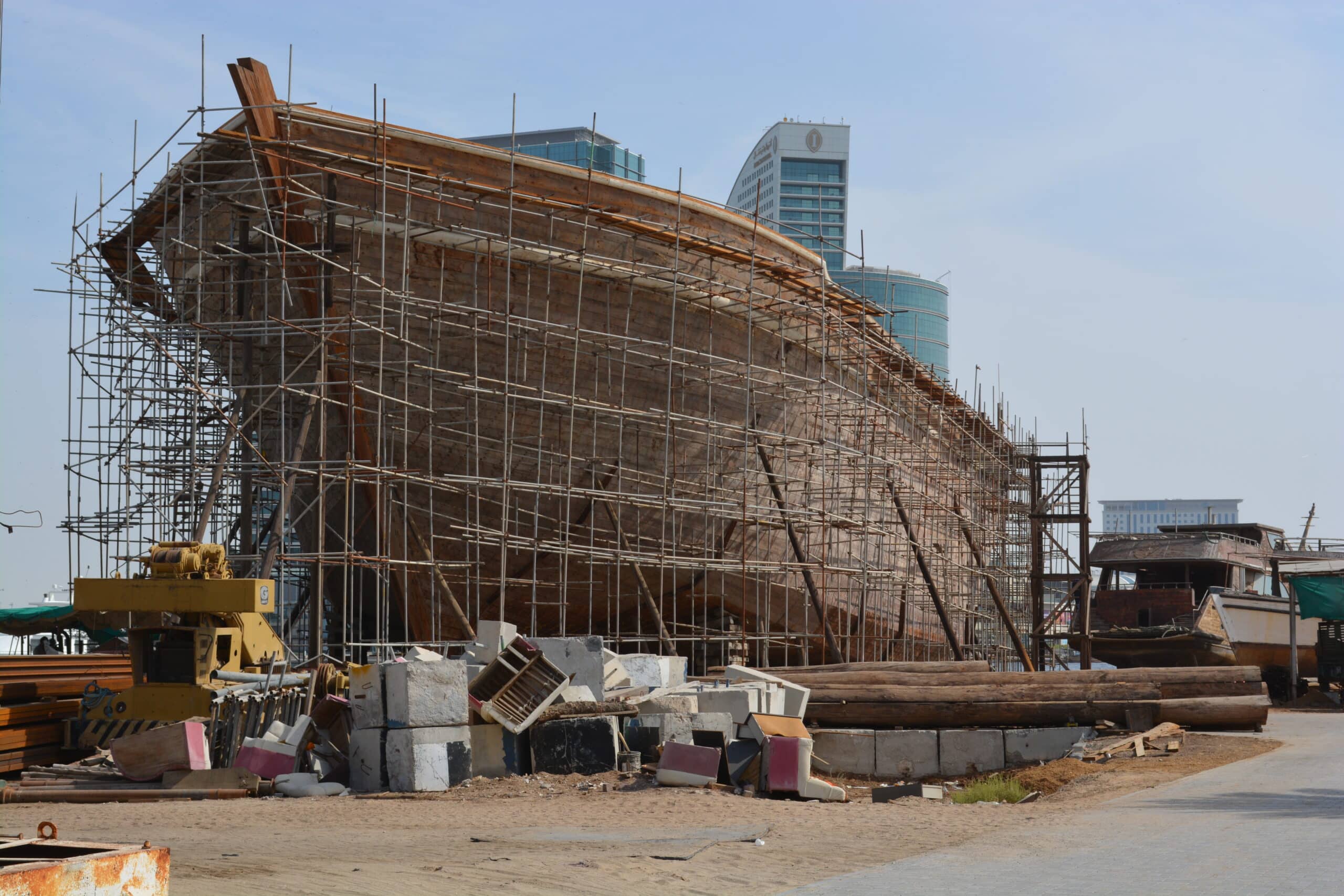
Introduction
The Dhow is one of the classic symbols that you see everywhere in Dubai; a wooden boat crafted using traditional methods that have stood the test of time. The Dhows are still used to trade goods from Dubai to India, Iran and other locations along the Persian / Arabian Gulf.
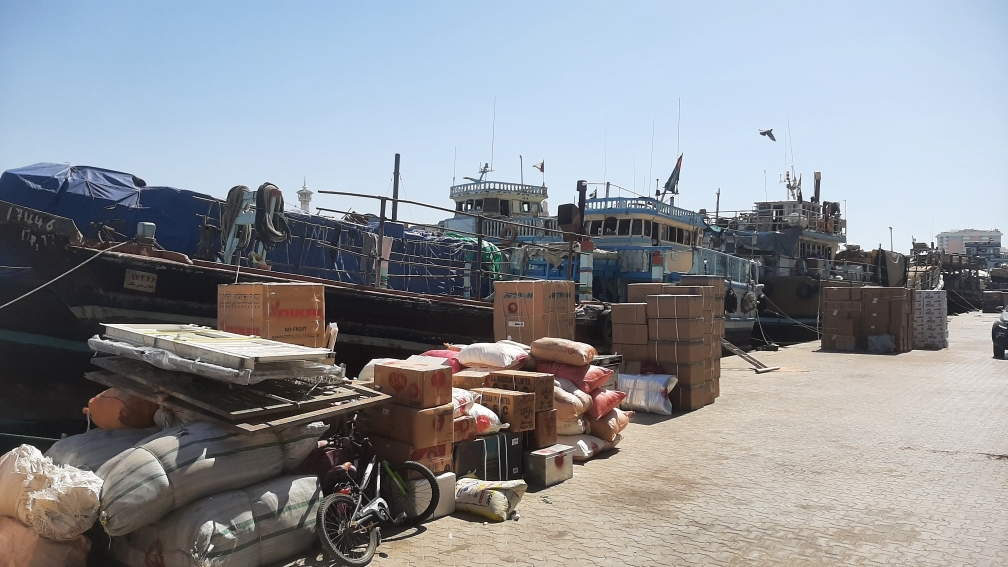
If you walk along the Dubai Creek in Deira you can see the dhows lined up ready to export goods or bring them from other locations as well. There is a certain romanticism in wandering where they are going and what they are carrying. I have seen items as big as cars and motorcycles being loaded onto the boats and lots of electrical equipment as well.
Key Takeaways
| Aspect | Detail |
|---|---|
| Cultural Significance | Dhows as a Symbol of Dubai’s Maritime Heritage |
| Tourist Experience | Dhow Cruises and Their Unique Appeal |
| Historical Context | The Evolution of Dhows in Dubai’s History |
| Modern Relevance | Dhows in Contemporary Dubai Lifestyle |
| Connection to Local Attractions | Linking Dhows with Dubai’s Cultural and Culinary Experiences |
Exploring the Legacy of Dhows in Dubai
The dhow, a traditional wooden sailing vessel, stands as a poignant symbol of Dubai’s rich maritime history. Its significance extends beyond mere transportation; it embodies the city’s cultural and economic evolution. From the serene waters of Dubai Creek to the bustling Spice Souq in Dubai, the dhow’s story is intricately woven into the fabric of Dubai’s identity.
The Historical Essence of Dhows
Dhows have long been the lifeline of the United Arab Emirates, particularly Dubai. Their historical relevance is evident in the way they shaped the region’s trade and cultural exchanges. These vessels were not only pivotal in the development of Dubai’s thriving spice trade but also played a crucial role in connecting the city to distant lands, fostering a unique blend of cultures and ideas.
A Glimpse into the Past
Crafted with skill and care, the creation of a dhow is an art form that echoes the traditions of a bygone era. Witnessing the construction of these majestic vessels offers a rare insight into Dubai’s past, long before the advent of its modern luxuries. The Al Fahidi Historical Neighborhood, a well-preserved area in Dubai, provides a vivid portrayal of this rich history.
Dhows in Modern Dubai
Today, dhows have transcended their traditional roles, becoming a symbol of the city’s rapid modernization while still honouring its roots. Iconic landmarks like the Burj Al Arab and the Dubai Opera, designed to resemble a dhow, highlight the vessel’s lasting impact on Dubai’s architectural landscape. Moreover, the dhow has become a centrepiece in tourism, with dhow cruises offering unique perspectives of the city’s skyline and a taste of Emirati hospitality.
The Dhow Cruise Experience
A dhow cruise is more than just a scenic journey; it’s an immersive experience of the Emirati way of life. As you glide along the Creek or the Dubai Marina, you’re treated to breathtaking views and a glimpse into the city’s harmonious blend of tradition and modernity. It’s an opportunity to savour Emirati food, often part of the cruise, and appreciate the intricate craftsmanship of the dhow itself.
The Art of Dhow Construction
The creation of a dhow is a meticulous process that combines traditional techniques with the knowledge passed down through generations. It’s a craft that requires not just skill but also a deep understanding of the sea and the materials used.
Traditional Techniques and Materials
Dhow builders traditionally used durable woods like teak or mahogany, known for their strength and longevity in marine environments. The construction process is an intricate art form, involving the shaping and fitting of wooden planks in a method known as carvel construction. This technique ensures a smooth hull, crucial for navigating the waters of the Arabian Gulf.
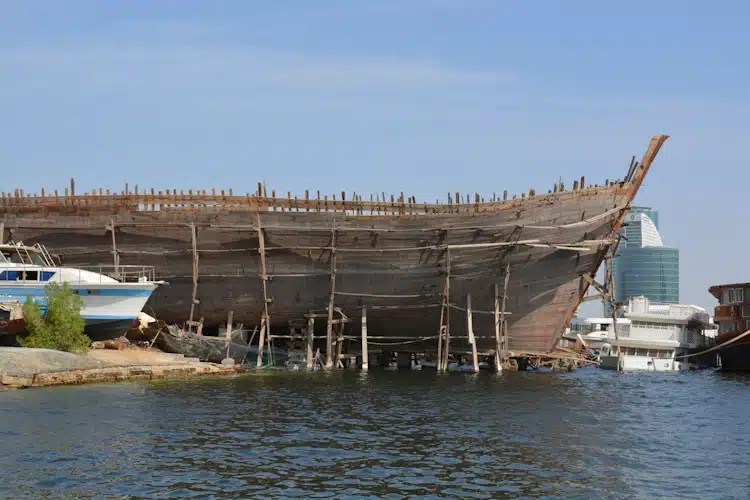
Shipyards and Their Legacy
The shipyards of Dubai, once bustling with the sound of dhow construction, offer a rare glimpse into this unique craft. While modern shipbuilding techniques have overtaken traditional methods, there are still places in Dubai where one can witness the age-old process of dhow construction. These shipyards are not just workplaces but living museums, showcasing the enduring legacy of Dubai’s maritime past.
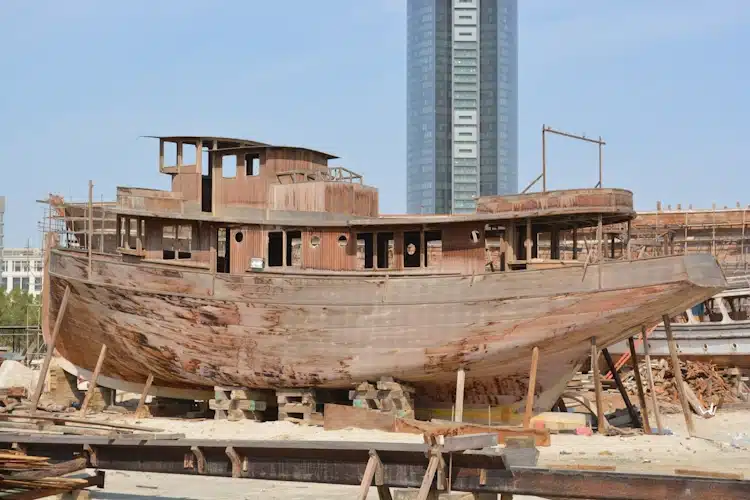
Dhows and Dubai’s Trade
Dhows were once the backbone of Dubai’s economy, facilitating trade across the Arabian Gulf, the Indian Ocean, and beyond. The Spice Souq in Dubai, a vibrant marketplace, owes much of its existence to the dhow trade routes that brought exotic spices, textiles, and other goods to the city’s shores.
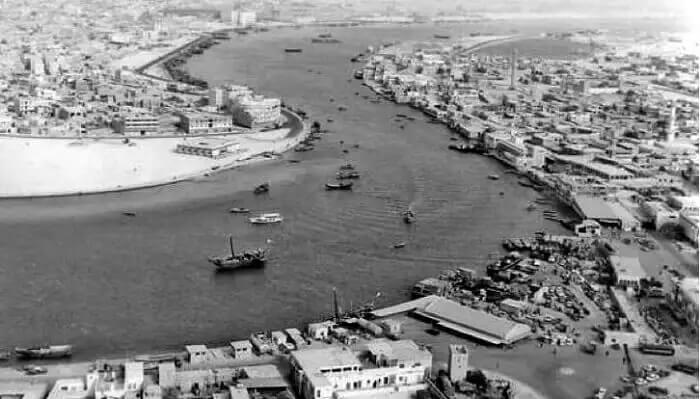
Dhows and Cultural Exchange
The trade routes established by dhows were not just economic pathways; they were conduits of cultural exchange. As dhows sailed from port to port, they carried not just goods but also ideas, customs, and traditions, enriching Dubai’s cultural tapestry.
The Al Jaddaf Boatyards
The Al Jaddaf boatyards in Dubai, with a history deeply intertwined with the city’s maritime heritage, stand as a living testament to the enduring legacy of dhow construction in the United Arab Emirates.
History and Significance of Al Jaddaf
Al Jaddaf, meaning “The Rower,” has a rich history as a dhow building area, dating back to when Dubai was a small fishing village centered around the Creek. Located in western Dubai in Bur Dubai, Al Jaddaf is bordered by the Dubai Creek and has historically been a crucial site for the construction and maintenance of dhows.
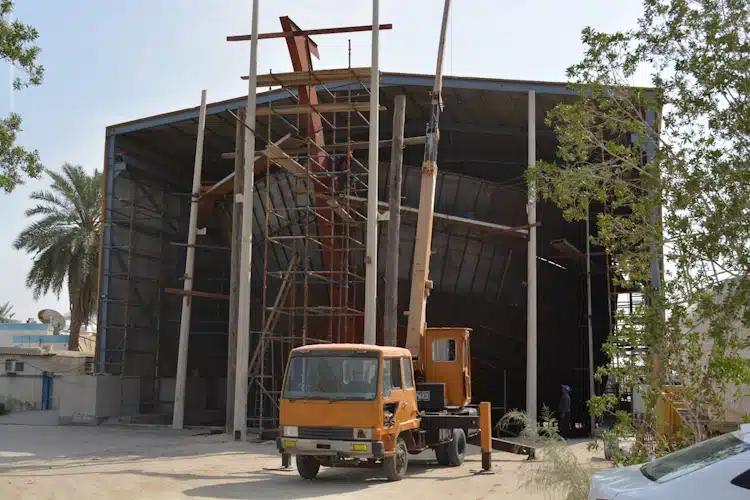
The Art of Dhow Construction at Al Jaddaf
At the Al Jaddaf shipyards, traditional dhow construction is still practised, keeping alive a craft that has sailed the Arab coasts for centuries. The construction process involves bending large wooden planks, securing them to create the frame and then carefully assembling the keel, stem, ribs, and rudder. This meticulous and labour-intensive process ensures that each dhow is not only seaworthy but also retains its traditional aesthetic and functionality.
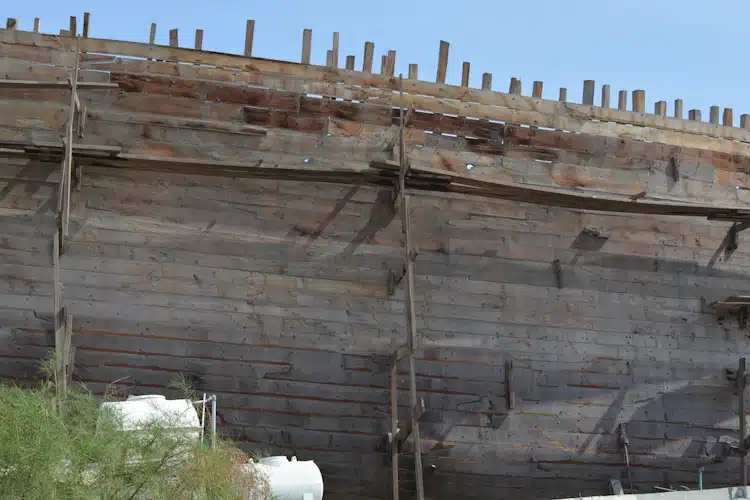
Modern-Day Operations and Innovations
Despite the modernization of Dubai, Al Jaddaf remains one of the few places where the traditional craftsmanship of dhow building is still active. Renowned shipbuilders, like Majid Obaid Al Falasi, have continued this legacy. Al Falasi, for instance, was recognized for constructing what was then the world’s largest wooden dhow, measuring 92 meters in length. This dhow, named ‘Obaid’ in honour of Al Falasi’s father, represents a blend of traditional craftsmanship and modern engineering, incorporating both wood and steel to enhance its strength.
Challenges and Triumphs
The journey of constructing these massive dhows is not without its challenges. Al Falasi’s quest to build the world’s largest dhow faced several hurdles, including issues with Guinness World Record recognition due to technicalities in defining a dhow. Nevertheless, the completion and launch of the dhow ‘Obaid’ in 2019 marked a significant achievement in preserving and advancing the traditional dhow-building craft.
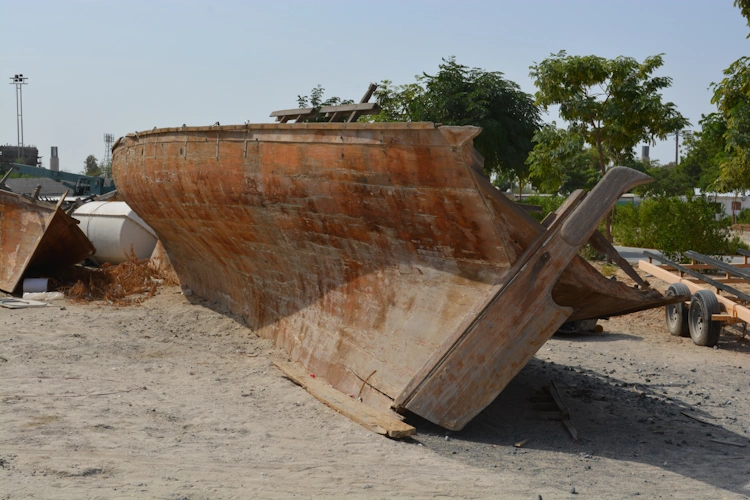
The Dhow’s Role in Contemporary Dubai
The influence of dhows and the Al Jaddaf shipyards extends beyond mere construction. Dhows are an integral part of the UAE’s landscape and culture, inspiring modern architectural marvels like the Burj Al Arab and the Dubai Opera. Furthermore, the establishment of the Marine Agency for Wooden Dhows in 2020 by the Ports, Customs and Free Zone Corporation (PCFC) underscores the ongoing importance of these vessels in Dubai’s maritime activities.
In conclusion, the Al Jaddaf boatyards not only preserve a crucial aspect of Dubai’s maritime history but also continue to contribute to the city’s evolving narrative, blending tradition with modernity in a city known for its dynamic transformation.
Dhows in Contemporary Dubai
In today’s Dubai, the dhow has evolved from a simple trading vessel to a symbol of the city’s luxurious and innovative ethos. This transformation is evident in various facets of Dubai’s lifestyle and infrastructure.
Dhows and Dubai’s Iconic Architecture
The dhow’s influence on Dubai’s skyline is unmistakable. Landmarks like the Burj Al Arab and the Dubai Opera, inspired by the dhow’s elegant design, showcase the city’s ability to blend traditional elements with cutting-edge architecture. These structures, much like the dhows they emulate, stand as symbols of Dubai’s journey from a humble fishing village to a global metropolis.
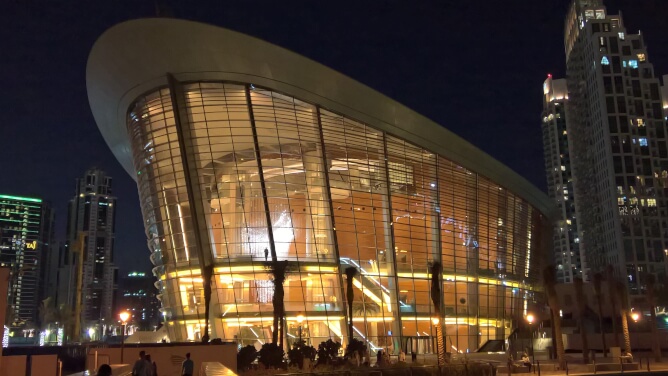
The Dhow Cruise: A Blend of Tradition and Luxury
Dhow cruises in Dubai are a perfect amalgamation of tradition and modern luxury. Tourists can experience the charm of old Dubai by sailing along the historic Dubai Creek or enjoy the opulence of the new city by cruising around the Dubai Marina. These cruises often feature gourmet dining, including Indian, Thai, and Italian cuisines, reflecting Dubai’s cosmopolitan character.
Celebrating the Dhow’s Legacy
Dubai’s reverence for its maritime heritage is evident in how it celebrates the dhow’s legacy. Events and festivals often feature dhow races, exhibitions, and cultural programs that pay homage to these traditional vessels.
Dhows and Cultural Festivals
Festivals in Dubai, such as those held at the Heritage Village Dubai, often include dhow exhibitions, showcasing the craftsmanship and history of these boats. These events provide a platform for sharing stories and preserving the skills involved in dhow building.
Dhows as Cultural Icons
The dhow is deeply ingrained in Dubai’s cultural ethos. It represents the city’s resilience, adaptability, and commitment to preserving its heritage amidst rapid modernization.
Dhows and Dubai’s Cultural Narrative
The story of the dhow is integral to understanding Dubai’s culture. These vessels symbolize the city’s historical ties to the sea and its transformation into a global hub. The dhow’s story is featured in various cultural mediums, from literature and art to music and dance, celebrating the rich maritime legacy of the UAE.
Dhows as Tourist Attractions
Dhows have become a major draw for tourists, offering a unique way to experience Dubai. The dhow cruise is a popular activity, combining sightseeing with cultural immersion.
A Journey Through Time and Culture
On a dhow cruise, tourists can witness the juxtaposition of old and new Dubai. Sailing along Dubai Creek or amidst the modern skyline of the Dubai Marina, visitors get a sense of the city’s dynamic evolution. These cruises often include stops at historic sites like the Al Fahidi Historical Neighborhood and modern marvels like The Atlantis Dubai.
Culinary Delights on a Dhow
Dining on a dhow is an experience in itself, with menus featuring a diverse array of cuisines. From traditional Emirati food to Indian, Thai, and Italian dishes, these cruises offer a taste of Dubai’s multicultural culinary scene.
Videos
Concluding Thoughts
The dhow is a testament to Dubai’s rich history and its vibrant present. It bridges the gap between the city’s humble beginnings and its status as a world-renowned destination. As we conclude this journey, we are reminded of the dhow’s enduring legacy and its role in shaping the narrative of this magnificent city.
FAQ
Here are 10 questions about how Dhows are made and used in Dubai, along with their answers:
- What is a Dhow in the context of Dubai?
In Dubai, a Dhow is a traditional wooden boat used historically for fishing and trading. It’s integral to Emirati culture and heritage and now popular for tourism, offering experiences of the traditional Emirati lifestyle. - How are Dhows made in Dubai?
Dhows are handcrafted using traditional techniques and tools, a craft passed down through generations. The process includes bending large wooden planks and assembling the frame, keel, stem, ribs, and rudder. - What are the different types of Dhows in Dubai?
Common types include the Baghlah, Battil, and Ghanjah, each with unique designs, constructions, and purposes. - What role did Dhows play in Dubai’s history?
Dhows were central to Dubai’s pearl diving industry and were used to trade pearls with India, Persia, and beyond. - Are traditional Dhow building techniques still practised in Dubai?
Yes, traditional Dhow building is still practised, especially in areas like Al Jaddaf, to preserve Emirati maritime traditions. - How significant are Dhows to the UAE’s landscape and culture?
Dhows are an integral part of the UAE’s landscape and culture, with landmarks like Burj Al Arab and Dubai Opera inspired by their design. - What are some recent achievements in Dhow construction in Dubai?
The world’s largest wooden Dhow, ‘Obaid’, was built in Dubai, measuring 92 meters in length and recognized by Guinness World Records. - How has modern Dhow construction evolved in Dubai?
Modern Dhow builders in Dubai, like Majid Obaid Al Falasi, have incorporated elements from different regions and even added steel for strength, pushing the boundaries of traditional Dhow construction. - What challenges are faced in maintaining the Dhow building tradition?
Dhow building in Dubai faces challenges like competing with modern shipbuilding and maintaining interest and skills in traditional craftsmanship. - What is the future of Dhow building and usage in Dubai?
Despite challenges, there is a dedicated effort to preserve Dhow building as a part of Emirati heritage, with builders like Al Falasi spearheading large-scale projects and maintaining the tradition.
Useful Links
- More information about dhows are here.
- Visiting Dubai? Check out the entry requirements.
- Next to the Dubai Shipyards on the Creek is the Mohammad Bin Rashid Library.
- Whilst in Dubai check out the Palm Jumeirah.
- The best beaches in Dubai are shown here.
- The best shopping in Dubai is at Dubai Mall, the Mall of the Emirates, and Ibn Battuta.
- Try out the Dubai Festival City for a great experience.
- Where does Dubai come from? Check out the History of Dubai.
- One of the most vibrant art and creativity locations: Alserkal Avenue.
